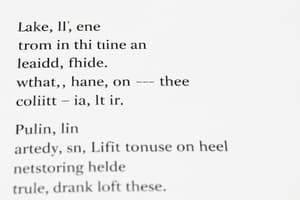Podcast
Questions and Answers
The symbols in human language are considered to be ________
The symbols in human language are considered to be ________
arbitrary
There is no intrinsic connection between the word '______' and the meaning of lion
There is no intrinsic connection between the word '______' and the meaning of lion
lion
Except for onomatopoeic words, most words in human language are ________
Except for onomatopoeic words, most words in human language are ________
arbitrary
Animals automatically know how to communicate without ________
Animals automatically know how to communicate without ________
Human language is acquired through a long ________ process
Human language is acquired through a long ________ process
A human being brought up in isolation does not acquire any ________
A human being brought up in isolation does not acquire any ________
Human language is conditioned by the ________, with some innate predisposition in newborns
Human language is conditioned by the ________, with some innate predisposition in newborns
The organization of language into two layers is known as ________ or double articulation
The organization of language into two layers is known as ________ or double articulation
Animals have a stock of basic ________ sounds which vary according to species
Animals have a stock of basic ________ sounds which vary according to species
Dolphins, gorillas, and chimpanzees have between 20 and 30 ________ sounds
Dolphins, gorillas, and chimpanzees have between 20 and 30 ________ sounds
Flashcards are hidden until you start studying
Study Notes
Patterning in Language
- English imposes strict rules regarding the permissible combinations and sequence of words in a sentence.
- Each word's placement is defined by its relationship with other words, forming a network of interrelated elements.
- Words must adhere to specific patterns; they do not exist independently but derive meaning from their position within the structure.
Structure Dependency
- Language operations require an understanding of a sentence's internal structure rather than merely counting elements.
- Example: In transforming a verb to past tense with "-ed," it is not simply about the second word; context matters.
- Incorrect applications of tense on sentence components demonstrate the need for structure awareness, as in "The womaned open the door."
Creativity (Productivity) in Human Language
- Unlike animals, humans possess the ability to communicate about virtually any topic, showcasing the feature of creativity in language use.
- Individuals can construct novel sentences that have never been expressed before.
Characteristics of Human Language vs. Animal Communication
- Human language is more organized than many animal communication systems, which typically consist of simple lists lacking internal structure.
- In English, sound combinations are governed by rules, allowing for certain arrangements while disallowing others (e.g., "bats," "tabs," "stab" are valid; "*sbat," "*abts," "*stba" are not).
Examples of Word Combinations
- Possible sentence formations using the example words: "the," "burglar," "sneezed," "loudly" include:
- "The burglar sneezed loudly."
- "Loudly, the burglar sneezed."
- "Loudly sneezed the burglar."
- "The burglar loudly sneezed."
- Invalid combinations include:
- "*The loudly burglar sneezed."
- "*Sneezed burglar loudly the."
Conclusion
- The interaction of elements in human language, defined by patterning, structure dependency, and creativity, underscores its complexity compared to simpler animal communication systems.
Studying That Suits You
Use AI to generate personalized quizzes and flashcards to suit your learning preferences.




